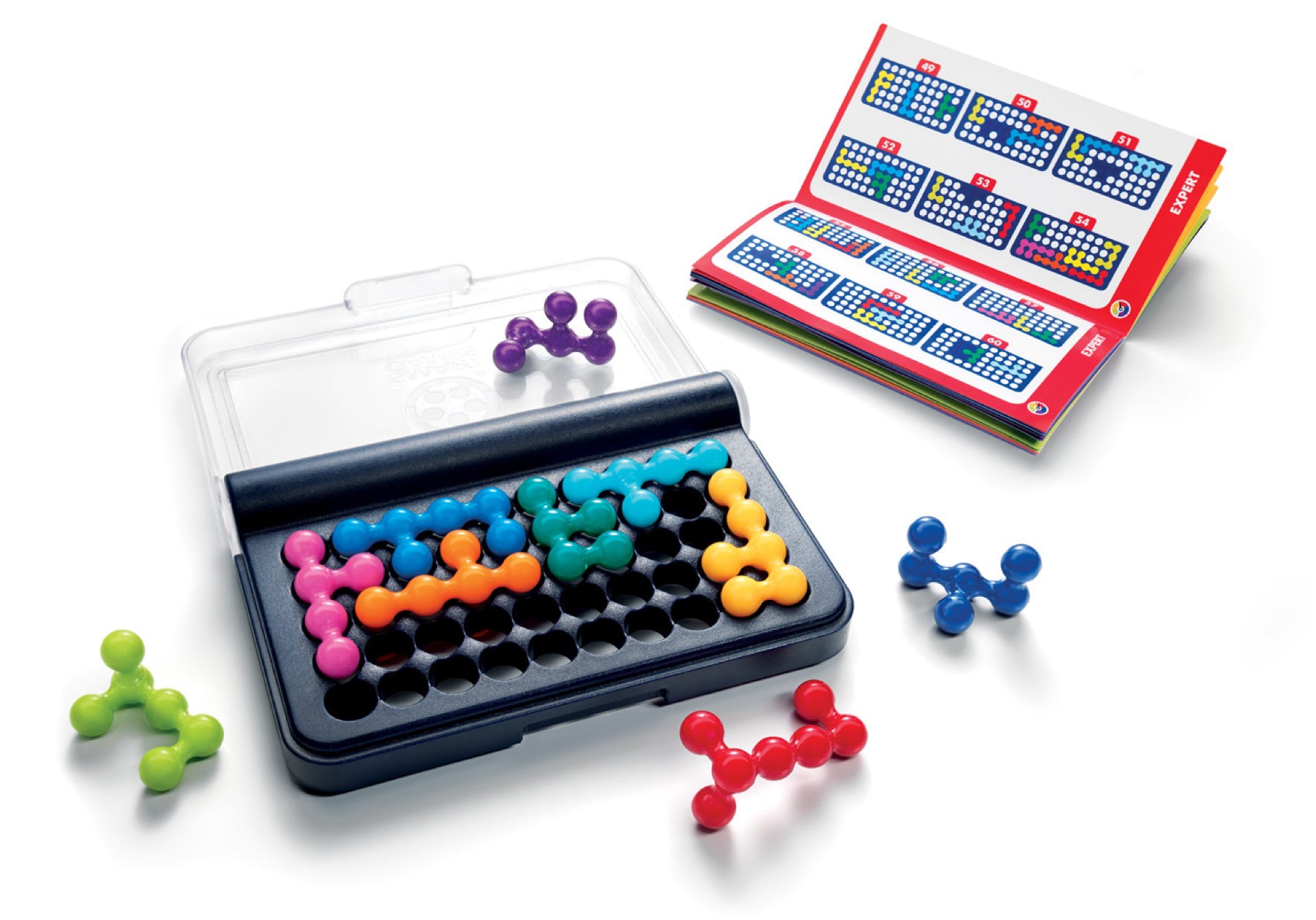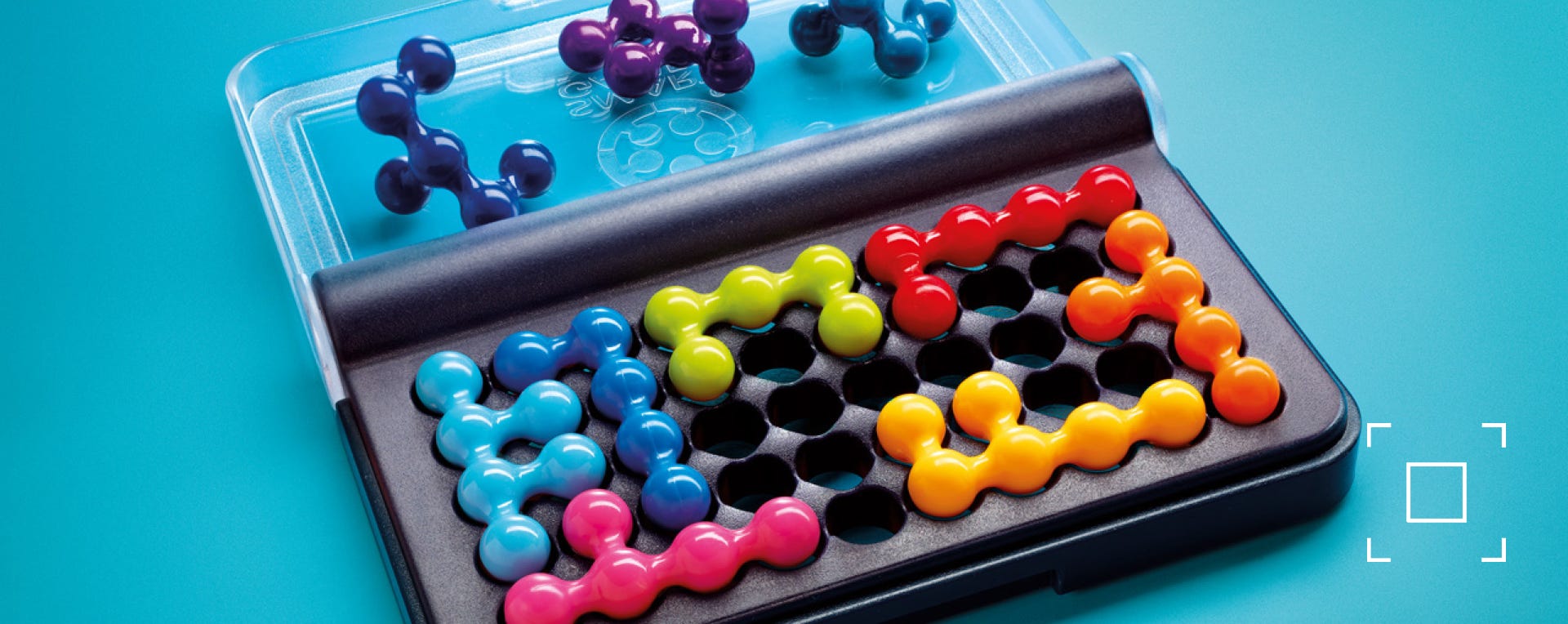IQ-Fit
The story behind the creation of IQ-Fit
Raf Peeters, January 2012
I designed IQ-Fit as a new variation to a popular puzzle theme: to fill up an area with puzzle pieces starting with already a few puzzle pieces on the game board. At first sight, it looks like IQ-Puzzler. But this is only so if you don't look very carefully. In fact, the concept is almost the opposite.
IQ-FIT IS THE OPPOSITE OF IQ-PUZZLER
With IQ-Puzzler you can make a 3D shape (a pyramid) with 2D puzzle pieces. But in IQ-Fit the puzzle pieces have balls sticking out in 3 dimensions. The object of this game is to create a 2D (flat) surface on the game board with 3D puzzle pieces. This is only possible if you "hide" one of the protruding sides of each puzzle piece inside the holes of the grid.
But wait, there is more. One of the protruding sides of each puzzle piece has 1 ball (A), the other side has 2 balls (B). So depending on how you orientate the puzzle piece, you get a puzzle piece with more or less visible balls. The game board has a grid with 50 holes. And all holes need to be covered by puzzle pieces. So if you start with puzzle pieces with a lot of balls, you might have puzzle pieces left over at the end with too many balls that don't fit. Or visa versa, you don't have enough balls to cover all holes. This is what really differentiates this game from all other 2D assembly puzzles.
CHALLENGES AND SOLUTIONS
Because you have 10 puzzle pieces with 2 different sides, there are in fact 20 different possibilities to choose from. You might think that this will lead to many solutions, but every challenge has just one. That is also different from the original IQ-Puzzler (not the newer PRO version), where most challenges have several solutions. The easiest challenges show you the position and orientation of 8 puzzle pieces, the hardest challenges show you only 2.
There are 120 challenges in this game. I started with 100 challenges, just like I did for IQ-Twist. But some people (and kids) found the first level of that game too difficult to start with. So we created 20 extra challenges for IQ-Fit that are very, very easy. So for puzzle experts the number of "real challenges" is 100.
FUN TO MANIPULATE
Although I personally don't like to solve this kind of puzzles (it drives me mad), I do like the way IQ-Fit looks. The shapes are balls connected to each other, but are more like little drops. And they also feel very nice to manipulate. When I developed this puzzle game, I decided to keep the bottom open, so that people with thick fingers (not to mention my boss) could easily lift up puzzle pieces from underneath the game board. This is still possible, although I never actually needed to do this when I play tested the challenges. But then again, I don't have thick fingers. The final product name is perfect. Your brain needs to be “fit” enough to “fit” all puzzle pieces on the game board. OK, stupid word play, but the working title for this game was "IQ-hole" and that didn't sound very commercially.
BTW, I get a lot of e-mails about people who found other ways to fill up the grid. There are 150.675 ways to do this, but we made a selection of the 120 most interesting for the challenges in the booklet. So don’t ask me if I forgot a specific one and that it can be included in the next revision. The answer on both questions is “no”, but if you like to search for all possible packings, I will not stop you ;-)

Both sides of the 10 puzzle pieces of IQ-Fit

Example of a challenge (left) and solution (right) of IQ-Fit


GAME RULES IQ-FIT
1) Pick a challenge and place the required puzzle pieces as indicated. These puzzle pieces may not change position.
2) Now put all the other puzzle pieces on the game board:
• Every puzzle piece has got two protruding sides. On one side there is one ball sticking out, on the other side two balls.
• Put your puzzle pieces with one of the sides down, so they fit in the holes of the game board.
• When you want to change the position of a playing piece, you can easily lift the piece by pushing it up with your fingers from under the bottom of the game board.
3) You have found the correct solution when all the puzzle pieces fit on the game board and there are no holes left visible on the board. Some protruding balls have to be fitted into the holes in order to create a totally flat top side. There is only one correct solution. You can find it in the back of the booklet.
Website ©2012 Raf Peeters
Products and images: © Smart
